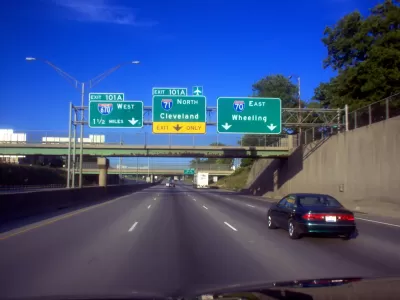The agency's recommendations are based on a new method of cost-benefit analysis that includes equity and environmental sustainability as key measures.

The Northeast Ohio Areawide Coordinating Agency (NOACA) is preparing to reject three proposals "to build new or enhanced highway interchanges" in the region, reports Steven Litt for Cleveland.com. The agency's recommendations "include turning down new full interchanges proposed at I-71 and Route 57 in Medina, I-71, and Boston Road in Strongsville, and I-271 and White Road in Northeast Cuyahoga County."
"The interchange recommendations are the first to be based on a detailed new method of cost-benefit analysis approved by the agency’s board in December." In addition to "traditional measures such as the local cost of traffic congestion, safety, and air pollution," the new method "also looks for the first time at issues such as racial and economic equity and environmental sustainability across the entire region."
"Among other things, the agency wants to create a clearer public understanding of how new interchanges could add to a decades-old, zero-sum pattern in which new points of access to interstate highways can spur local development that moves jobs, tax base, and investment from older communities to newer ones."
"For far too long, policies have favored sprawl and increased vehicle miles traveled. The legacy of past policies have had negative implications for our environment and have negatively impacted vulnerable communities," Cleveland Mayor Frank Jackson's office said in a statement. "we must ensure our infrastructure investments support diversity in transportation options, [and] do not contribute to sprawl, and that we are reversing the implications of climate change."
FULL STORY: NOACA ready to say ‘no’ to three new suburban highway interchanges based on detailed cost-benefit analysis

Trump Administration Could Effectively End Housing Voucher Program
Federal officials are eyeing major cuts to the Section 8 program that helps millions of low-income households pay rent.

Planetizen Federal Action Tracker
A weekly monitor of how Trump’s orders and actions are impacting planners and planning in America.

Ken Jennings Launches Transit Web Series
The Jeopardy champ wants you to ride public transit.

Rebuilding Smarter: How LA County Is Guiding Fire-Ravaged Communities Toward Resilience
Los Angeles County is leading a coordinated effort to help fire-impacted communities rebuild with resilience by providing recovery resources, promoting fire-wise design, and aligning reconstruction with broader sustainability and climate goals.

When Borders Blur: Regional Collaboration in Action
As regional challenges outgrow city boundaries, “When Borders Blur” explores how cross-jurisdictional collaboration can drive smarter, more resilient urban planning, sharing real-world lessons from thriving partnerships across North America.

Philadelphia Is Expanding its Network of Roundabouts
Roundabouts are widely shown to decrease traffic speed, reduce congestion, and improve efficiency.
Urban Design for Planners 1: Software Tools
This six-course series explores essential urban design concepts using open source software and equips planners with the tools they need to participate fully in the urban design process.
Planning for Universal Design
Learn the tools for implementing Universal Design in planning regulations.
Ada County Highway District
Clanton & Associates, Inc.
Jessamine County Fiscal Court
Institute for Housing and Urban Development Studies (IHS)
City of Grandview
Harvard GSD Executive Education
Toledo-Lucas County Plan Commissions
Salt Lake City
NYU Wagner Graduate School of Public Service


























